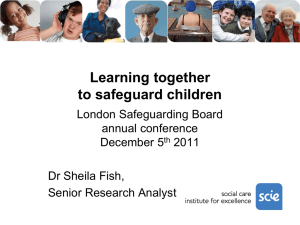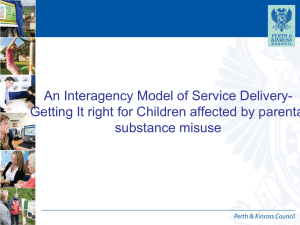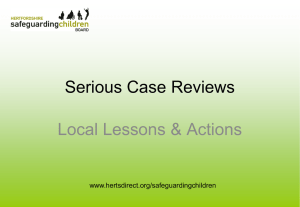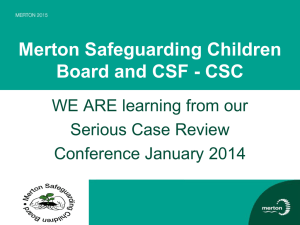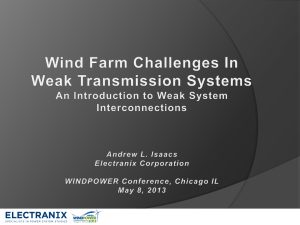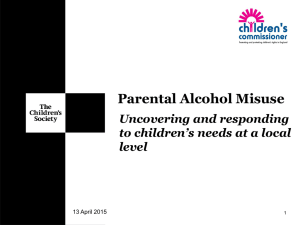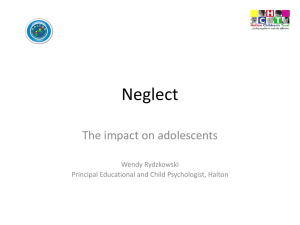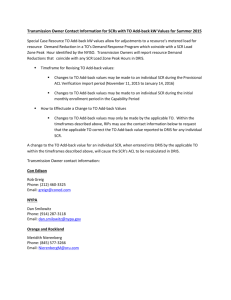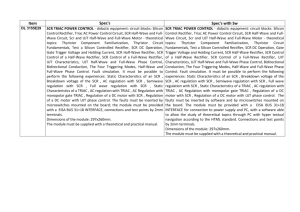learning from serious case reviews and audits
advertisement
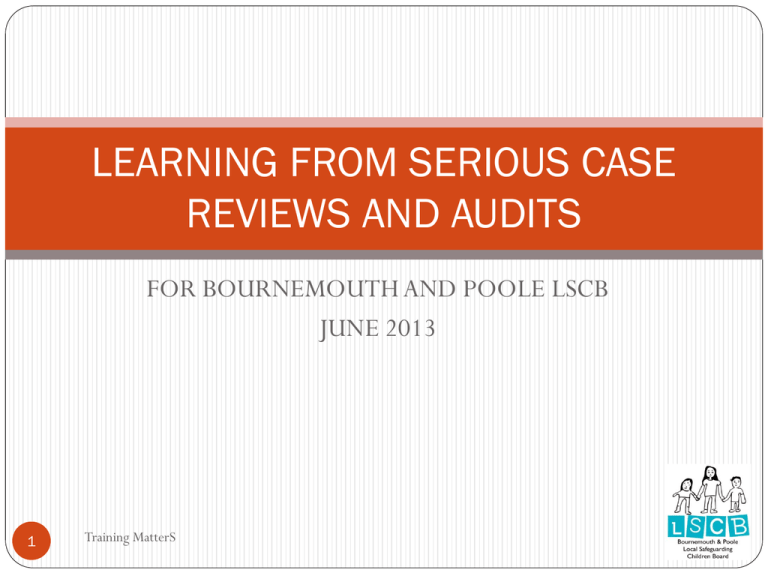
LEARNING FROM SERIOUS CASE REVIEWS AND AUDITS FOR BOURNEMOUTH AND POOLE LSCB JUNE 2013 1 Training MatterS AIMS AND OBJECTIVES AIM All participants will understand serious case review learning and be able to relate this to their work By the end of the session participants will be able to State the key messages from recent local serious case reviews and audits Apply this learning to their team’s own work to improve practice 2 Training MatterS BLAME Person centred approach to explaining errors creates blame culture driven by society’s desire to avoid risk World seems less dangerous – someone to blame Once we know the outcome, over-estimate what could have been anticipated Procedures are about visible tasks but judgement and expertise required (Munro 2010) 3 Training MatterS PRACTICE LEARNING EVENTS Future SCR’s and audits Will be looking systematically at what went wrong and well 4 – moving to understanding, not blame Meaningful involvement of practitioners and family members Seeking to understand practice from the viewpoint of individuals and organisations at the time, not hindsight Looks not just at what professionals did but why they acted as they did Develops key themes for analysis and look at lived experience of the child Training MatterS WHICH CHILDREN MOST AT RISK? Vulnerability factors Co-morbidity of parental problems Cumulation of negative childhood experiences Genetic transmission of parental disorders Involvement in parental delusions Drug use Protective factors Quick resolution of parental problems Day to day presence of a safe caring adult Child’s own temperament, coping strategies (Cleaver et al 2011) 5 Training MatterS FAMILY C6 CASE AUDIT 10 week baby bruising and multiple fractures Mother history of depression and mental health problems Variable engagement with services Domestic violence history Use of historical information to inform assessments Questioning ongoing issues 6 Training MatterS FAMILY C8 Tragic suicide of mother of 4 children Significant long term mental health needs August 11 CP plans for younger 2 – mother’s unpredictable behaviour December 11, mother told application for care orders, killed herself 7 Training MatterS FAMILY C8 Cont. Good practice Regular communication between professionals Child-centred approach Responsiveness to mother despite volatility Robust recording Challenges Working with parents behaving inconsistently and at times mental health needs dominated parenting Geographical relocation affected mental health support 8 Training MatterS FAMILY C8 Cont. Delay in full mental health assessment of mother’s parenting capacity Psychiatric reports from 2006 not included in current assessments Value of shared chronologies Importance of maintaining focus on child in need once CP plan ceased Importance of using historic information when further pregnancies 9 Training MatterS LINKS WITH MENTAL HEALTH PROBLEMS 1 Parents with mental health problems high risk of living in poverty very low employment rates isolation fear and experiences of stigma, discrimination. ⅓ young carers have a parent with mental health problems Most parents not physical risk to children 10 10 Training MatterS LINKS WITH MENTAL HEALTH PROBLEMS 2 More risk to safety when parents psychotic and multiple mental health difficulties and socially deprived Parents with mental health problems may be less available emotionally to children Compensation by other relatives and friends (J Tunnard 2006) Toxic trio – risks to welfare of children is 14 times where DV, mental ill health and abused in past themselves (Cleaver et al 2011) 11 11 Training MatterS LINKS WITH MENTAL HEALTH PROBLEMS 3 Impacts more further into system 43% of conferenced families (Brophy 2003) 33% of fatal child abuse (Falkov 96 ) 60% national SCR 09-11 parents mental health issues 12 12 Training MatterS GROUP WORK 1 How can we more effectively manage the welfare of children where parents have mental health problems or substance misuse? How can we keep more useful chronologies and use historical information more effectively to protect children? “live tool for improving practice” and “vital tool to assist reflection, analysis, decision-making, planning, and intervention in the lives of children and their families” (Hollows 2012) 13 Training MatterS CASE AUDIT M/C December 2011 concerns children not sufficient care and supervision, home conditions poor and mother misusing alcohol. Discussion with children – unannounced visit at end of school day – removal of youngest children of 4. Identifying and responding to concerns Long history with school, HV and EWS Common response of poor engagement by mother 17 referrals to Social Care since 1999 as concern peaked Unusually high range of referring agencies Sect 47 not met and no Family Support Service 14 Training MatterS CASE AUDIT M/C Cont. 2004 attempts by Social Care to engage - closed Chronology not updated – cumulative and repetitive concerns When closed, not usually multi-agency plan for follow up. Services over optimistic re sustaining improvements Referral agencies could have challenged Social Care decisions Father was not in family home and not involved in assessment or planning Little involvement with children by Social Care Older children caring for younger two – one 2004 referral to young carer’s service. 15 Training MatterS CASE AUDIT M/C Cont. Children protective of their mother Hard to engage/ responses Health managed proactively – home visits School proactive – compensatory care multi-agency planning meeting would have helped Bruising of 8 month old – insufficient corroboration of 16 mother’s account – no medical or further assessment. Poor school attendance Indicators of neglect/poverty over sustained period Overcrowded accommodation Alcohol misuse and mental health problems in mother disclosed but not diagnosed or treated or effect on children considered Training MatterS GROUP WORK 2 How can we ensure the voice of the child is not lost? In what ways can we communicate better between agencies when there are different views about the level of response needed? 17 Training MatterS INTER-AGENCY WORKING Challenges about listening to agency concerns and accepting views of others Difficult for schools to maintain their support role Insufficient acknowledgement of their role Insufficient weight to school’s concerns Unreasonably high thresholds for neglect and emotional abuse Inadequate feedback and advice Insufficient timely information about individual families Often therefore supported single agency as school and not part of multi-agency plan 18 Training MatterS (Ward et al 2012) ESCALATION AND CHALLENGE Need to be able to challenge other agencies Pan Dorset multi-agency escalation protocol Address concerns at lowest level possible within 5 days or 19 less – practitioners Unresolved concerns about safety and welfare of child escalated first to team manager level within 5 days or less Passed up to Service manager, head teacher level Up to heads of service if remains unresolved and on to LSCB Record and date at every stage Training MatterS NATIONAL RESEARCH - THE VOICE OF THE CHILD : LEARNING LESSONS FROM SCR 2010 1 67 SCR Importance of listening to the child Child not seen frequently by professionals or not asked 20 their views or feelings Safe trusting environment needed for child to share views What is the child trying to tell us? Recognise behaviour as a means of communication Agencies didn’t listen to adults who spoke up for child – neighbours, grandparents Training MatterS NATIONAL RESEARCH - THE VOICE OF THE CHILD : LEARNING LESSONS FROM SCR 2010 2 Parents and carers prevented access to child Practitioners focused on parents, especially vulnerable ones, and overlooked implications for child Over reliance on parents’ report Tendency to overlook fathers and male partners Agencies didn’t interpret findings well enough to protect child 21 Training MatterS NATIONAL RESEARCH - THE VOICE OF THE CHILD : LEARNING LESSONS FROM SCR 2010 3 Direct observation of babies and young children and linking 22 this to risk factors Assess disabled children and protection needed Consider risks to children if professionals concerned for own safety Protection for home educated children Implications of DV for unborn child Vulnerabilities of young carers Training MatterS PROTOCOL FOR NON MOBILE CHILDREN All non mobile children with bruise or burn referred to Social Care and paediatrician All non mobile with bleeding nose or mouth, swelling of head, reduced movement in a limb discussed with paediatrician Where referral, Social Care will Take and record details Check if known Discuss with paediatrician 23 Training MatterS CASE REVIEW SD Family moved between areas 6 children, 3 fathers Concern about oldest – ADHD and violent July 2010 Referral to Social Care – concerns about mother and 24 father (of youngest 4) ability to parent, safety and hygiene March 2011 – father left, greater concerns Mother Mental ill health Home Conditions poor Basic care chaotic Older child (11) main carer Training MatterS SD Cont. November 2011 Children’s services requested dad take care of 4 youngest CP plan for neglect December 2011 SD hospital Critically unwell Diabetes Frozen watchfulness Low weight Developmental delay due to environment 25 Training MatterS SD Cont. Lack of chronologies No multi-agency meeting Health professionals were unaware of the state of the home Reviewing of CIN needs to be robust and have clear actions planned 26 Training MatterS RULE OF OPTIMISM Tendency of workers to over estimate ability of parents to understand professional concern and make the necessary changes (Selwyn 2006) Reasoning processes of social workers Valued family maintenance and sought to bolster this Viewed service users as capable of change and honest (Keddell 2011) Assessment of facts and interpretation challenging for all workers 27 Training MatterS GROUP WORK 3 How can universal and specialist services work more effectively and assertively intervene in neglect cases? What can help to challenge the drift towards optimism by professionals? 28 Training MatterS HARD TO REACH FAMILIES Lack of parental engagement leads to less intervention due to non-cooperation. Obstruction reduces access to evidence (Farmer and Lutman 2009) Quick turn around of assessments makes it harder to identify families accurately (Broadhurst 2010) Hostile parents can trigger defensive, impersonal workers – low levels of listening and empathy (Howe 2010) 29 Training MatterS WORKING HARDER TO ENGAGE WITH CHILDREN,YOUNG PEOPLE AND FAMILIES MORE EFFECTIVELY W case audit Where agency refers to another and failure to engage – may 30 not realise Make effective clear referral Communicating clearly with family Raising confidence of family in specialist service Communicating to specialist service any potential difficulties and any strategies that may work Making appropriate and personal invitation Training MatterS WORKING HARDER TO ENGAGE WITH CHILDREN,YOUNG PEOPLE AND FAMILIES MORE EFFECTIVELY Use of language Appropriate responses if family fail to attend and to repeated failure to attend Identifying families who are disguising lack of cooperation and compliance or are hostile or violent Appropriate responses to complaints about service providers as an avoidance technique Ongoing communication with the referring agency 31 Training MatterS NEGLECT GUIDANCE 1 Easy to focus on adult needs and lose sight of the child (Burgess et al 2011) To prevent drift and “start again” Helps with uncertainty about thresholds Compensatory care Disguised compliance or false engagement Rule of optimism Clarify fact and opinion Younger child more risk 32 Training MatterS NEGLECT GUIDANCE 2 What is it like for this child in this family? Focus on family but not to exclusion of child Share information Get help – environmental health, fire service Framework for recording conditions in home Graded Care Profile 33 Training MatterS BABY J SERIOUS CASE REVIEW Died aged 5 months 2012 Co-sleeping on sofa with mother who had consumed large amount of alcohol Parents not living together, 2nd child DV concerns in relationship – not taken seriously enough History of mother would have led to concerns – troubled adolescent and risky behaviour. Maternal risk factors: Alcohol and drug misuse Criminal activity including assaults Childhood history of watching DV Family history of SA 34 Training MatterS BABY J Cont. Coped well with first child Referral to Children’s Social Care 6 wks before death after 35 complaints to Housing by neighbour – did not meet threshold for action, no feedback Little attention to father of two children – lack of curiosity How effective were early help arrangements? Response to safeguarding concerns timely? Further promotion of safe sleeping learning Family using children’s centre- 3 assessment models in use Dangers of start again and rule of optimism Training MatterS ENGAGING FATHERS Men much less engaged in CP process than women 60% men not talked to prior to initial CP meeting DV underplayed and sanitised Little attention to men’s practical caring skills Violent men more likely to be engaged than non-violent – categorized as irrelevant unless a threat (Baynes and Holland 2012) 36 Training MatterS LINKS WITH SUBSTANCE MISUSE Parents misusing substances 52% of case on CP plan 62% proceedings parental substance misuse ‘the more serious type of case being studied, the higher the proportion in which substance misuse was an issue’ (Forrester and Harwin 2006) alcohol central substance of concern high incidence of crack cocaine use both strongly correlated with violence (Manning 2009) Parental abuse of alcohol or drugs in 50% of neglect cases (Dunn 2002) 42% national SCR 09-11 parents misusing substances 33% fathers and 66% mothers with problem drug use still living with their children 37 37 (Advisory council on misuse of drugs 2003) Training MatterS LINKS WITH DOMESTIC VIOLENCE Two thirds of conference cases (Sloan 2003) Physical risks , 30-66% of children living with DV direct abuse (Edleson J 1999) Emotional abuse of witnessing violence 65% of national SCR 09-11 DV 86% one of three toxic factors Twice as likely as non-DV houses to have confirmed neglect by age 5 years (Davies and ward 2012) 38 38 Training MatterS EFFECT OF CHILDHOODS ON PARENTS Parents who were physically abused or neglected in childhood were more likely to treat their own children the same way – Distorted beliefs Unrealistic expectations Not age-appropriate Over-reacting or coercive parenting Harsh punishment (Hindley et al 2006) 39 Training MatterS INTERVENTION WITH FAMILIES Parents who succeeded in making changes Less likely to have experienced abuse To have come to terms with removal of older child Gained insight from that Used support Many parents go through the motions – appointments, never really active partners, some active saboteurs Some defining moment – change to meet baby’s needs SW assessments failed to focus on core issue LT support or intervention not there (Ward et al 2012) 40 Training MatterS GROUP WORK 4 How are we doing engaging hard to reach families? How can we improve this? Why do we keep hearing the same messages in SCR’s and audits? What blocks are there that stop change happening? 41 Training MatterS CO-SLEEPING RESEARCH Link between bed sharing and sudden infant death syndrome UNICEF study 1472 cot deaths called for definite stand against all bed sharing especially up to 3 months Increased risk with recent consumption of drugs or alcohol (Blair 2009) Different opinions on co-sleeping for non risk groups Co-sleeping guidance and e-training for all front line staff and for parents– Dorset Healthcare 2011 – pathways. 42 Training MatterS CO-SLEEPING GUIDANCE Safest place for baby to sleep is in cot by bed Sleeping with baby on sofa puts baby at greatest risk Baby shouldn’t share a bed with Smoker Consumed alcohol Taken legal or illegal drugs making them sleepy Increased risk of SIDS Parents in low SOE groups Parents who currently abuse alcohol or drugs Young mothers with more than one child 43 Premature infants and low birth weight Training MatterS SEXUAL EXPLOITATION OF CHILDREN AND YOUNG PEOPLE Up to 18 Danger of seeing risk as informed consenting choice 5 years age difference, exchange of goods Lists indicators Child sexual exploitation risk assessment tool and matrix Low risk – single agency response Medium risk- TAC and CAF Medium/high risk – Refer to Social Care, strategy meeting, possible S 47 and interim safeguarding plan 44 ©Training MatterS

